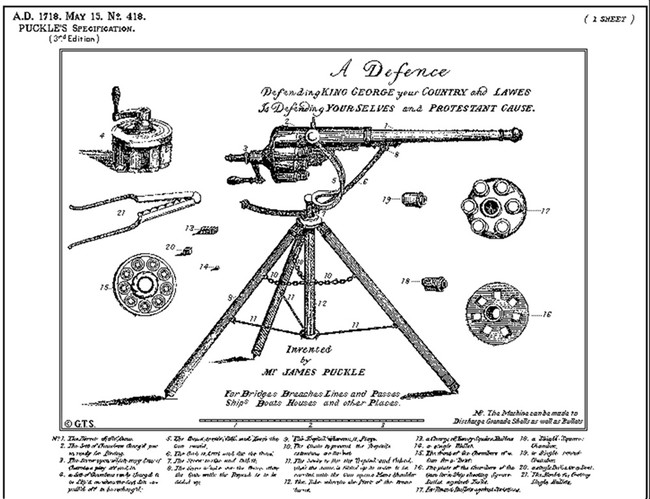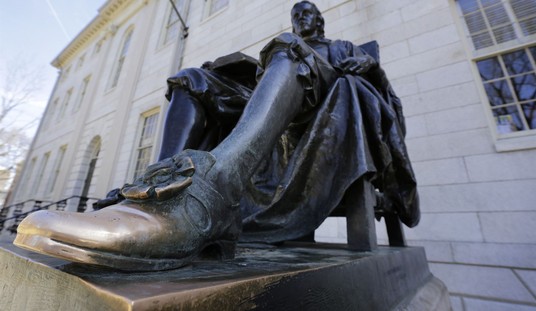The History of War
The history of mankind is the history of conflict, and throughout said conflicts, a lot of mental horsepower and creativity has been devoted to finding more and better ways to un-alive one’s enemies, preferably faster, more accurately, and at a reasonable cost. This led to the development of repeating firearms a lot sooner than most people might realize, especially leftists who run to their fainting couches at the very notion of a repeating rifle. (Just wait until they learn of the power and long-range accuracy of a typical big-game bolt gun.)
A while back we discussed the Collier flintlock revolver, an interesting bit of firearms history that may well have been the inspiration for a young man whose name would become immortal, Sam Colt. But long before the Collier revolver was made, there was another rotating-cylinder flintlock repeater, and it was the first weapon to which the term “machine gun” was ever applied. That piece, named after its inventor, was the tripod-mounted Puckle Gun.
James Puckle and His Gun
James Puckle was a British lawyer, inventor, and writer with an eye towards firearms development. In 1717, he submitted to the Royal Navy Ordinance Board a novel weapon: A repeating flintlock gun mounted on a tripod with a revolving cylinder allowing the user to fire several shots before reloading. The Royal Navy, those aficionados of rum, sodomy, and the lash, were all of a staid, unadventurous sort where new hardware like this was concerned and so turned Puckle down. Mr. Puckle, however, wasn’t done yet. In 1718, Puckle obtained a patent for his piece, but he failed to raise enough money to put the Puckle Gun into production. In the end, there may have been as few as a dozen or so produced.
But what an odd piece it was! The Puckle Gun could fire nine rounds a minute, which is a pretty impressive rate of fire when you consider that the elite British troops did well to fire three shots a minute from their Brown Bess muskets. The Puckle Gun, depending on which drawings you consult, held from six to eleven loads in the cylinder, and the cylinders came in pairs – not to speed reloading but for a much different purpose.
Here’s where the mind of James Puckle took a nasty turn: He proposed two versions of the Puckle Gun, one for use against Christian foes and once against Ottoman (Muslim) Turks. The first version would fire a standard round ball, while the second would fire an odd square projectile – to cause greater pain and suffering. Geneva, at that time, had nothing to say about the proposal, although it would probably be viewed askance by the war crimes tribunals of more modern times.
At the time, it was (incorrectly) believed the latter would cause more serious injuries, which would, in turn, “convince the Turks of the benefits of Christian civilization.”
Uh-huh. That may indeed have resulted in some nasty wounds. But then, as I can attest from personal experience, any gunshot wound is a nasty wound.
See Related: Fauci's Assessment of Trump's Gunshot Wound Is Designed to Minimize the Seriousness of What Happened
How it Worked
 Here’s how the Puckle Gun worked:
Here’s how the Puckle Gun worked:
After each shot, the shooter turned a crank on the rear of the threaded shaft on which the cylinder turned. This disengaged the cylinder from the barrel, allowing the cylinder to be turned by hand, bringing the next loaded chamber into battery.
Rotating the cylinder also caused a rather Rube Goldbergian device to close the firing pan on the spent chamber and open the pan on the new chamber, preparing it for the addition of priming powder. The crank was then turned back down, sealing the cylinder against the barrel. The pan was then primed, and the gun was ready to fire again.
Rinse and repeat, and you have what was, for the times, a pretty rapid-fire, high-capacity repeating firearm.
The Puckle Gun was not, mind you, something the individual soldier could tote around in combat. In this, it did resemble a more modern machine gun, in being a crew-served weapon mounted on a tripod. This is a piece, though, that would have made any gun banners of the time clutching at pearls.
See Related: Kamala Harris Would Be the Most Anti-Second-Amendment President in History
There were problems. The Puckle Gun would have been effective had it been reliable; it wasn’t. Its mechanism was clunky and prone to problems. In the end, only two were ever used in any manner of deployment, when one John Montagu, the 2nd Duke of Montagu, Master-General of the Ordinance from 1740 to 1749, bought two Puckle Guns for a 1722 expedition to capture the Caribbean islands of St. Lucia and St. Vincent, although there’s no account of them being used in combat.
Where Can You See One?
There are a few surviving examples of the Puckle Gun.
Two are on display at the homes of the aforementioned Duke of Montagu, presumably (but not verified, as far as I’m aware) to be the ones he took on his Caribbean expedition. There is a replica gun in the Buckler’s Hard Maritime Museum in Hampshire, England, and amazingly three Puckle Guns made their way to China, where they were presented to the Chinese Emperor and reportedly reside to this day in Beijing’s Palace Museum.
And finally, one brass Puckle Gun was purchased in 1718 by Tsar Pyotr I, and that piece may now be viewed in the Military History Museum of Artillery, Engineers and Signal Corps in St. Petersburg.
The Implications
While James Puckle’s weapon never really caught on, it was part of the trend toward repeating military and, of course, civil weaponry. The Puckle Gun was not only one of the pioneering pieces of revolving-cylinder designs that would eventually lead to such famous pieces as the Colt Single Action Army and my own favored N-frame Smith & Wesson revolvers, but at the time, the Puckle Gun was mostly a curiosity, impractical, clunky and unreliable.
Even so, the example of the Puckle Gun demonstrates two things:
- Never underestimate an inventor with an idea and his eye on the main chance, and
- Soldiers will always be ready to try something new that will allow them to un-alive the enemy with greater efficiency.
Repeating firearms are almost as old as firearms themselves. None of this is new, the protestations of the gun-grabber hordes notwithstanding. If we learn nothing else from James Puckle and his gun, we should learn that.














